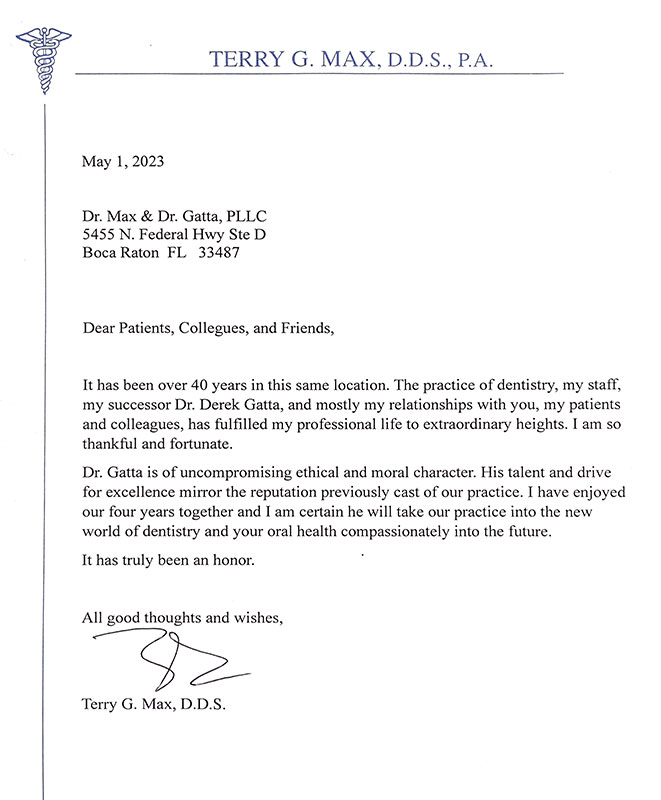Think of missing teeth as cracks in your smile’s pavement. While patching them might seem optional, letting them grow can create bigger problems. Act now to prevent the cracks from widening and enjoy a smooth, confident smile for years to come. Dr. Gatta and his excellent team are here to get all your questions answered and care for you in excellence.
It’s not uncommon to have missing teeth. In fact, a survey in 2015 found only 48% of American adults ages 20–64 have a full permanent (or secondary) set. Nearly 1 in 5 seniors over 65 are missing all of their teeth (called edentulism). Genetic conditions, gum disease, injury, cavities, and tooth decay are among the many causes of tooth loss.
Tooth loss can affect chewing patterns, cause bone loss, and impact self-esteem, and it can lead to other health conditions if left untreated. Fortunately, there are ways to restore your smile, such as with dental implants, dentures, and dental bridges. This article discusses the causes and impact of tooth loss or lack of tooth development, as well as what you can do about it.
Causes of Missing Teeth
All people lose their initial, or primary, set of teeth (commonly known as baby teeth) as they age. However, the 32 secondary (adult) teeth that replace the original are permanent. That said, a wide range of conditions, health issues, and other factors can cause tooth loss or raise the risk of it.
Genetics
In some cases, secondary teeth never form due to an inherited malformation of the upper and lower mandible (jawbone). Called tooth agenesis, this type of tooth loss can occur with certain congenital conditions, including cleft palate and lip (a split in the upper lip and roof of the mouth) and Down syndrome (trisomy 21, a genetic disorder caused by the presence of a third chromosome 21).
The three kinds of congenitally missing teeth are:
- Hypodontia: The most common form of agenesis, hypodontia is when one to five adult teeth never form after the primary ones fall out.
- Oligodontia: Oligodontia is when six or more teeth are absent due to agenesis.
- Anodontia: In anodontia, secondary teeth never develop at all, and there is a complete absence of a set.
Gum Disease
Another common cause of missing teeth is gum disease, which causes spaces between gums and teeth referred to as pockets. Over time, this can cause teeth and bones to decay and tissue to recede, which leads to tooth loss.5
Causing inflammation, redness, and bleeding in the gums, gingivitis is a mild form. It’s generally reversible with good dental care and hygiene. If untreated, though, gum disease progresses to periodontitis, in which plaque buildup moves below the gumline.5 This prompts extensive treatment.
Injury
Of course, sports injuries, falls, car accidents, and other kinds of trauma can cause you to lose teeth. Losing an entire tooth in this manner requires immediate attention from your dentist or an endodontist, a dental specialist. Try to see a doctor within a half hour.
Caring for a Lost Tooth
If you’ve lost a tooth due to trauma or a fall—and after calling for immediate help—try to reposition the tooth back into its socket. If that doesn’t work, store it in a glass of milk or hold it in your mouth next to your cheek as you travel to the dentist. Don’t wrap lost teeth in paper towels, clean it with any chemicals, or touch the exposed root.
Additional Risk Factors
A number of other dental health conditions and behaviors raise the risk of developing missing teeth, including:
- Tooth decay due to cavities
- Poor nutrition
- Smoking
- Lack of access to dental care
- Poor dental hygiene
In addition, severe tooth loss is significantly higher in those with a number of diseases, including:
- Diabetes (when your body has difficulty processing sugar)
- Heart disease
- Asthma (inflamed airways making it difficult to breathe)
- Emphysema (lung disease)
- Liver problems
- Rheumatoid arthritis (RA, an autoimmune disease affecting the joints)
- Stroke (a disruption of blood flow to the brain)
Recap
People develop missing teeth for a variety of reasons, including certain genetic conditions, gum disease, injury, and trauma. Tooth decay, poor nutrition, smoking, and poor dental care all raise the risk, as do certain chronic diseases, such as diabetes and heart disease.
Impact of Missing Teeth
Many reasons missing teeth should be taken care of. The following is a breakdown of the impact of tooth loss:
- Difficulty chewing and swallowing
- Dietary issues and insufficient eating (related to the above)
- Lowered self-esteem and sense of attractiveness
- Altered bite (even one missing tooth will cause surrounding teeth to migrate)
- Loss and deterioration of bone
- Weakened jaw muscles and structure
- Increased risk for further tooth loss, cavities, or other dental problems
Options for Replacing Missing Teeth
Given how essential taking care of missing teeth can be, and how common the issue is, it’s little wonder that there are options for restoring your smile. Along with the long-standing approach of wearing dentures (false teeth), dentists and endodontists offer several newer treatments. There’s no need to live with tooth loss.
Dental Implants
When the task is to replace a single tooth, dental implants are a particularly promising option. These create permanent false teeth that are crafted to blend in with yours. Getting an implant is a multistep process that includes:
- Imaging and evaluation: Since the post that secures the implant will need to be embedded in the jawbone, the first step involves ensuring that the bone is healthy enough to support it. Computerized tomography (CT) scanning or other imaging methods will be used to assess the area.
- Augmentation: If the jawbone is found to be of insufficient strength to support the implant, surgery will be needed first to add additional bone or bone-like material to the area. The procedure itself only proceeds after the bone has fully healed, something that can take several months.
- Placing the screw: A titanium screw is put into the jawbone, which mimics a tooth’s root. This screw is capped and the area heals in about three to six months, with bone matter growing around the screw (osseointegration).
- Adding the crown: Once the screw is firmly embedded in the jawbone and everything is healed, there’s a final procedure. The healing cap is taken off the screw, and a post (an abutment) is placed on it. Then, a crown designed to fit in with the contours (and color) of the surrounding teeth is put in place.
Dentures
Entire or partial sets of false teeth, dentures, may be necessary in cases of significant tooth loss. These are worn as needed and taken out at night.
The two kinds that are used are:
- Partial dentures are worn to replace one or a few teeth.
- Complete dentures replace an entire row of teeth on the upper and/or lower jaws.
Living with dentures does require particular care, including cleaning them properly and avoiding certain foods and drinks.
Dental Bridges
Effective for replacing multiple missing teeth at a time, installing a dental bridge is a third option. These sets of artificial teeth are attached to a bracket (the bridge), which is cemented to supporting structures: either healthy teeth with crowns or implants.
Though the procedure to put dental bridges in place isn’t as invasive as that for implants, several appointments are required. Here’s a breakdown:
- Imaging and impression: Imaging is used to assess the area, and an impression is taken of the surrounding teeth. This will help ensure the dental bridge fits appropriately in the mouth and that your bite remains natural.
- Building support: Before a permanent bridge is placed, crowns are put on supporting teeth (or dental implants) and you’re fitted with a temporary bridge.
- Permanent bridge: In the final procedure, the permanent bridge is fitted and cemented into place. Follow-up appointments are needed to ensure everything is working.
Take control of your oral health and pave the way for a confident, complete smile – the sooner you start, the easier the journey. Schedule an appointment today with us by calling (561) 997-6622. Head over to our Instagram for daily tips and information. We can’t wait to meet you!
Reference: [https://www.verywellhealth.com/missing-teeth-5209485]















